
The last few weeks have been momentous ones for the island of Cuba. For the first time in six decades, large numbers of Cubans recently took to the streets to protest the oppressive communist regime. Since then there have been mass arrests and government-imposed internet and media blackouts. It is not clear how this will all play out, but during this time of hope, uncertainty, and brutality, many eyes and hearts are looking toward the Patroness of Cuba, la Virgen de la Caridad del Cobre (Our Lady of Charity of Copper) for help and strength.
The Virgen de la Caridad del Cobre, or “Cachita” as she is fondly called by many Cubans, has played a historic role in the history and spirit of Cuba similar to that of Our Lady of Guadalupe in Mexico. Her image is to be found everywhere, in Churches and shrines, in homes, even on taxis, uniting Cubans in a sense of their identity as a people.
The story began sometime around 1612 with three slaves: two young native American brothers and a twelve-year-old boy of African origin. They have gone down in history as “los tres Juanes.” The three were workers in the mines, and had taken a canoe into the sea off the north coast of Cuba in search of salt. As they went along they saw something riding on the water some distance away. At first they first thought it was the body of a bird, but as they got closer they saw to their surprise that it was an image of the Blessed Virgin, resting on a small piece of wood, holding the child Jesus and dressed in a beautiful cloth gown. Written on the wood were the words: “I am the Virgin of Charity.” The statue, despite being tossed about on the waves after a recent storm, was completely dry when they recovered it. They brought the image back to their small town, and it was eventually installed in a chapel in a village called “El Cobre” because of its proximity to the copper mines. A special devotion developed there toward Our Lady of Charity “del Cobre” and soon spread to the rest of the island.
During Cuba’s fight for independence in 1868, the Virgen del Cobre was the symbol of the independence movement. In 1916 she was declared Patroness of Cuba. When Ernest Hemingway, a lover of all things Cuban, won the Nobel Prize for Literature in 1954, he gave his medal to the shrine of the Virgen del Cobre.
The current Basilica, located not far from the original site, was begun in 1927. It houses the five-hundred-year-old statue of the Virgin, and has been a center of pilgrimage and prayer for Cubans, who look to the Virgen de la Caridad in good times and in bad, but especially in bad. She is known to be close to the poor and the suffering. During this tense time for Cuba, we can all join our Cuban brothers and sisters in their hopes and prayers for their homeland.
Virgen de la Caridad, Salva Cuba!
Photo Attribution A: "El Santuario de la Virgen del Cobre" by DnTrotaMundos is licensed under CC BY 3.0.

The First Draught
To receive the Weekly Update in your inbox every week, along with our weekly Lectio Brevis providing insights into upcoming Mass readings, subscribe to The First Draught.
